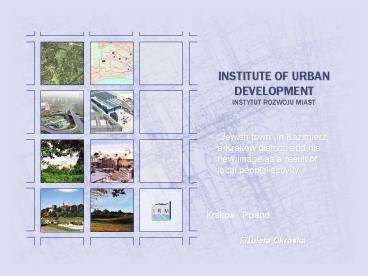INSTITUTE OF URBAN DEVELOPMENT INSTYTUT ROZWOJU MIAST - PowerPoint PPT Presentation
1 / 27
Title: INSTITUTE OF URBAN DEVELOPMENT INSTYTUT ROZWOJU MIAST
1
INSTITUTE OF URBAN DEVELOPMENTINSTYTUT ROZWOJU
MIAST
Jewish town in Kazimierz, a Krakow district,
and his new image as a result of local people
activity
Krakow Poland
Elzbieta Okraska
2
Krakow-citys present days
- lies in the southern part of the country, on the
Vistula River - administrative centre of the Malopolska Region
- the former capital of Poland and royal residence
- unique city - inscribed with the district of
Kazimierz, and with the Salt Mine in Wieliczka in
the UNESCO World Heritage List - place where tradition integrates with modernity
- academic, scientific and research centre
- culture capital of Poland
3
Krakow
4
Citys present-day
- 18 districts
- 327 sq. km
- 757 000 inhabitants
5
Citys present-day
6
Krakow - history
- founded in 1257 based on the Magdeburg law which
gave a city a new layout with a centrally
situated marketplace - important European city even in mediaeval times
- 1364 foundation of the Krakow Academy
- greatest development of Krakow (both economic and
cultural) took place in the period from early
14th century to early 17th century - at the beginning of the 17th century, Krakow lost
its importance, although it preserved its formal
role as the site for royal coronations, burials,
royal weddings or celebration of victories on
battlefields - during a partition period, economic collapse of
Krakow has started but at the same time, Krakow
remained the cultural capital of Poland and
became a centre of national liberation movement
7
Kazimierz - present days
- located at the junction of the Malopolska Upland
and Pogórze Karpackie, on the left bank of the
Vistula - the former independent town
- presently part of District I of Krakow
8
Kazimierz - history
- founded in 1335 based on the Magdeburg law
- designed to become a competitive centre of trade
and crafts - location of the university was to ensure the
supremacy of Kazimierz to Krakow - in the Middle Ages one of the major Polish towns,
second to Krakow - the 16th century was its heyday period
- in 17th century economic prosperity ended
drasticaly - during the time of partition the municipality of
Kazimierz was liquidated and in 1800 the town
Kazimierz was incorporated into the "Great
Kraków" to become one of its districts - from then on, the history of Kazimierz was linked
with that of Krakow
9
Citys heritage
10
Citys heritage
11
Jewish town- Oppidium Iudaeorum
- 1495 the Jews were forced to leave Krakow and
move to the town of Kazimierz, where the area of
the future ghetto was allocated to them, and
where they stayed for almost 400 years - first half of the 16th century - drastic
persecution of Jews all over Europe resulted in a
strong immigration movement to Kazimierz - end of 16th century - creation of an
international cultural centre of a high level and
a wide impact area - a sort of a separate "Jewish
town, an autonomous enclave - 1583-1608 the ghetto was twice extended, had
separate walls with three gates and retained this
shape until the 1800 (the end of Jewish town) - 19th - 20th century - the Jewish population
gradually began to dominate the whole Kazimierz
and the neighbouring district of Stradom - 1867- the Jews were granted equal civil rights
- orthodox Jews remained in Kazimierz, while part
of the former Oppidum Iudaeorum was inhabited
only by the poorest people and ultra-conservative
fractions of the Jewish community - until the outbreak of World War II, Kazimierz was
a Jewish district, with a specific culture and
atmosphere
12
Jewish town- Oppidium Iudaeorum
13
Jewish town- Oppidium Iudaeorum
14
Kazimierz post-war period
- 1939 1945 the Holocaust gave final end to the
existence of Jewish district as well as to the
common, 700-year Polish and Jewish history - after the liberation, Kazimierz did not return to
its previous condition due to - - mass emigration of the Jewish community
that had survived the pogrom and which was their
response to the waves of anti-Semitism sweeping
over Poland - - repeated introduction of less wealthy
social groups to Kazimierz - - general neglect of historical buildings
- period of political and economic transformation
in Poland brought real changes
15
Kazimierz post-war period
16
Revival of the Jewish district
- the crucial date, after which the cultural
"revival" of the Jewish Kazimierz started, was
1988, or the year, when the first edition of the
Jewish Culture Festival in Krakow took place - the first Festival was informal, but the second
one in 1990 turned out to be already an
international event. Since 1994, this is a
world-famous, annual event - another event, which helped to "promote" most
efficiently and most quickly Kazimierz on the
world market was Steven Spielberg's "Schindler's
List", which was shot in Kazimierz in 1993. The
film caused that visitors began to arrive - 1993- the Centre for Jewish Culture was
established by the Judaica Foundation - soon after that Jarden, the first and only Jewish
bookshop in Poland opened in Kazimierz, an
independent Scena EL-JOT theatre, Laznia Theatre
Association, Galicja Museum, as well as numerous
art galleries and antique shops
17
Revival of the Jewish district
- The creation of that new image was, in its major
part, a spontaneous process, a work by
individuals (those committed and those with a
"vision", though not necessarily representatives
of the local community). Then came the new,
non-public cultural institutions, and next
private entrepreneurs
18
Revival of the Jewish district
19
Revival of the Jewish district
20
Revival of the Jewish district
21
Revival of the Jewish district
22
Revival of the Jewish district
23
Revival of the Jewish district
24
Revival of the Jewish district
25
Revival of the Jewish district
26
Revival of the Jewish district
27
Revival of the Jewish district































